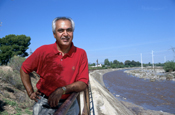UC Irvine Hydrology Center Named Joint Winner of UNESCO’s 2007 Great Man-Made River International Water Prize
Center for Hydrometeorology and Remote Sensing is first institution to be awarded prize
 The United Nations Educational, Scientific and Cultural Organization (UNESCO) has named the Center for Hydrometeorology and Remote Sensing (CHRS) at UC Irvine and the National Science Foundation Science and
The United Nations Educational, Scientific and Cultural Organization (UNESCO) has named the Center for Hydrometeorology and Remote Sensing (CHRS) at UC Irvine and the National Science Foundation Science and
The prize recognizes outstanding achievements and contributions in advancing the assessment, development, management and use of water resources in arid and semi-arid areas, such as ground and surface water availability and usage in areas subject to drought and desertification.
The two centers were recognized “for their action in strengthening the capacity to manage the water resources of arid and semi-arid areas around the globe through a network of international and regional cooperation.”
Presented biennially by the director-general of UNESCO, the prestigious Great Man-Made River Prize has only been awarded three times, in 2001 and 2005; this is the first time it has been awarded to U.S. institutions.
Soroosh Sorooshian, Ph.D., distinguished professor in civil and environmental engineering and Earth system science, was the founding director of SAHRA and is the founding director of the CHRS at The Henry Samueli School of Engineering at UC Irvine.
“Receiving this award is wonderful news and a great tribute to our primary funding agencies, NASA and NOAA, the outstanding group of colleagues like Professors Gao, Hsu and Imam, and the students who came from the University of Arizona to UC Irvine and helped found the CHRS. This is a good example of a situation when, with intelligent, dedicated, hard-working colleagues, one can achieve a lot in a short amount of time,” said Sorooshian. “The news was even sweeter having the
Together with his colleagues, Xiaogang Gao, Ph.D., Bisher Imam, Ph.D., and Kuo-lin Hsu, Ph.D., all adjunct professors of civil and environmental engineering, Sorooshian has built the CHRS into an internationally-recognized center generating the latest in hydrologic information useful in weather and climate studies and water resource management.
A primary goal of CHRS has been to develop the means to extend the benefits of space and weather agencies’ vast technological resources into applications that can assist hydrologists and water resource managers worldwide. The core of this system is a sophisticated model called Precipitation Estimation from Remote Sensing Information using Artificial Neural Networks and Cloud Classification System (PERSIANN-CCS), which runs in parallel at UC Irvine and at the National Oceanic and Atmospheric Administration’s (NOAA) National Environmental Satellite, Data, and Information Service (NESDIS). This system provides global satellite precipitation maps at four kilometers spatial and three hours temporal resolutions, which provides the level of detail needed to estimate how much rainfall is produced as a result of a thunderstorm.
Scientists and students at CHRS, with support from NASA and NOAA, have pioneered a number of state-of-the-art models capable of converting satellite observations to useful hydrologic information. Their global real-time rainfall product, which is used for flood prediction, especially in developing countries, has become especially important.
Kuolin Hsu, Bisher Imam,
The CHRS team also conducts state-of-the-art research on the hydrometeorology and hydroclimatology of the semi-arid region. A current project led by Gao and Research Associate JiaLun Li, addresses the interaction between irrigation practices in
A unique collaboration between CHRS, led by Imam and
Sorooshian credits the center’s support from NASA, NOAA and UNESCO for its success over the last four years, as well as the vision of Ralph Cicerone, Ph.D., chancellor emeritus, Michael Gottfredson, Ph.D., executive vice chancellor and provost, William Parker, Ph.D., chair and professor of physics and astronomy, and Nicolaos Alexopoulos, Ph.D., dean of The Henry Samueli School of Engineering, in inviting them to UC Irvine and supporting the establishment of the CHRS.
The prize award will be presented on World Science Day, Nov. 10, in the Hungarian Parliament in
